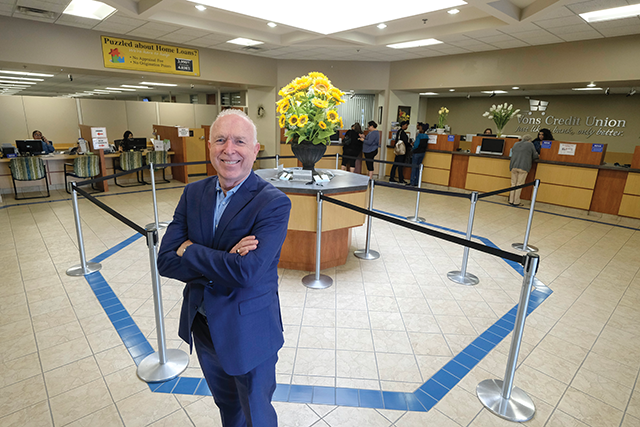The number of credit unions in Los Angeles County has plummeted by nearly 60% over the past 20 years as a wave of consolidation swept through the industry.
While the overall number of community lending institutions has dropped dramatically, the industry itself has grown — with membership, loans and deposits all reaching record levels.
There are 102 credits unions in L.A. County, down from 249 in 2000, according to data provided to the Business Journal by Ontario-based trade group California and Nevada Credit Union Leagues.
Some of the push to consolidate has come as smaller credit unions struggled to compete with larger nonprofit institutions that offer lower interest rates on loans and higher rates on deposits. Security features tied to online banking, which can be difficult for smaller credit unions to afford, also were a driving factor, according to industry insiders and experts.
El Monte-based Vons Employees Federal Credit Union, a $610 million-in-asset institution that last month changed its name after acquiring Certified Federal Credit Union, has merged with four credit unions in the past eight years. The most recent mergers involved the $48 million-in-asset, Cerritos-based Auto Club Federal Credit Union in February, and the $30 million-in-asset, downtown-based Metropolitan Water District Federal Credit Union in October 2018.
“The smaller and mid-sized credit unions are having difficulty,” observed Stephen Weakley, Certified’s chief executive and president.
Other recent local credit union mergers include West Hollywood-based Cedars-Sinai Federal Credit Union, which merged into Anaheim Hills-based Credit Union of Southern California on May 1; Studio City-based CBS Employees Federal Credit Union, which was taken over in March by Westwood-based University Credit Union after the chief executive of CBS Employees was charged with embezzling $40 million from the credit union over a period of 20 years; and Glendale-based California Credit Union, which merged with San Diego-based North Island Credit Union more than two years ago to create a $3.1 billion-in-asset institution.
Buying up banks
Even though the mergers have been mostly between credit unions, some for-profit bankers are concerned by the increased number of multi-billion-dollar-in-asset credit unions acquiring small banks — a trend that has been picking up steam over the past two years.
A Washington, D.C.-based trade group, the Independent Community Bankers of America, raised alarms earlier this month when it announced plans to form a task force to potentially put roadblocks in place to stop these transactions.
“The current rash of mergers is yet another indicator that tax-exempt credit unions have become virtually indistinguishable from taxpaying commercial banks,” said Rebeca Romero Rainey, president of the community bankers’ group.
Rainey said the recent surge in credit union acquisitions of community banks furthers the industry’s encroachment into full-service banking and heightens questions about whether federally chartered credit unions — which are exempt from taxes — should continue to receive that preferential treatment.
Michael Bell — a lawyer in Royal Oak, Mich., who has helped close nearly three dozen deals where credit unions purchased banks — said the number of acquisitions isn’t at a problematic level and that more are on the horizon.
Bell said he is working on two deals in California where credit unions are attempting to purchase banks, including one in the Los Angeles region. He declined to identify the credit unions involved or their commercial bank targets. If the deals close, they would be the first in the state, Bell said.
“The trend has been ramping up since 2017, and there are more sellers and more buyers, and the pricing is at a good level,” he said. “This isn’t rocket science.”
Credit unions, Bell added, are typically looking to purchase banks with assets between $600 million and $1 billion. The deals are always cash because credit unions are not publicly traded and do not offer stock considerations.
L.A. stands out
Geoff Bacino, a former board member of the industry’s regulatory agency, National Credit Union Administration, said the pace of credit union consolidation has shown signs of slowing in the past two years — though not in heavily populated Los Angeles County where the rate remains higher than national averages.
“Nationally it is slowing down, and it’s slowing down because there are fewer and fewer credit unions, and fewer opportunities to merge,” Bacino said. Less than a year ago, the credit union system had 5,700 institutions, down 45% from the 10,300 in 2000.
At the forefront of the merger mania over the past 20 years has been Credit Union of Southern California, which now has 114,000 members stretching across Los Angeles, Orange, Riverside and San Bernardino counties.
The $1.53 billion-in-asset SoCal Credit has been involved in more credit union mergers in the Western United States than any other institution. It has completed 21 mergers since 2000, including eight in L.A. County.
An estimated 56% of SoCal Credit’s $1.31 billion in deposits are derived from Los Angeles County, according to data provided by the credit union. The institution went on a torrid merger pace from 2012 to 2016, picking up 14 credit unions and 46,000 members.
“Although we’ve done 21 mergers, we’re not going out knocking on doors,” Dave Gunderson, the chief executive at SoCal Credit, said. “Credit unions are coming to us asking to become a merger partner. We offer more services and branches.”
Gunderson said most of the institutions that have merged into his had less than $100 million in assets.
The move to consolidate into larger institutions hasn’t put a damper on membership.
While the number of credit unions is shrinking in L.A. County, membership topped 3 million in the quarter ended March 30 while the industry added 18,300 new members in the last year. Overall membership in Los Angeles is at a record high, according to industry data.
Meanwhile, total loans for L.A. County credit unions have grown to $35.5 billion in 2019’s first quarter, up 9% from the period a year ago; deposits have reached $43.6 billion, up 5% during the same timeframe. Deposits also hit an all-time high in the county.

